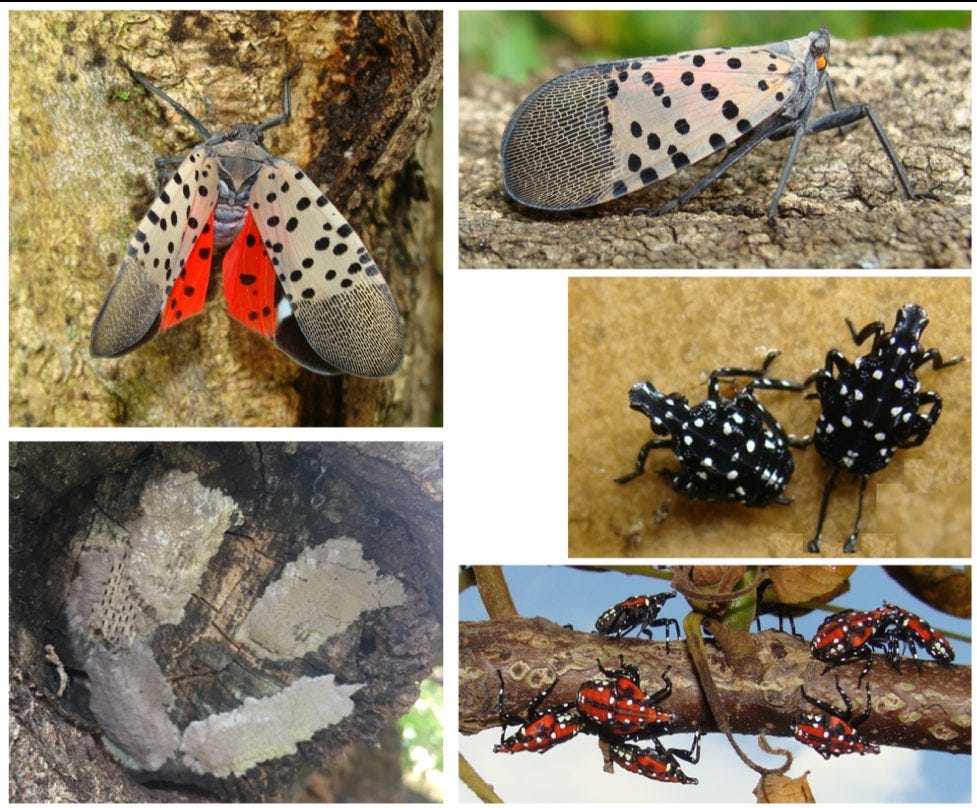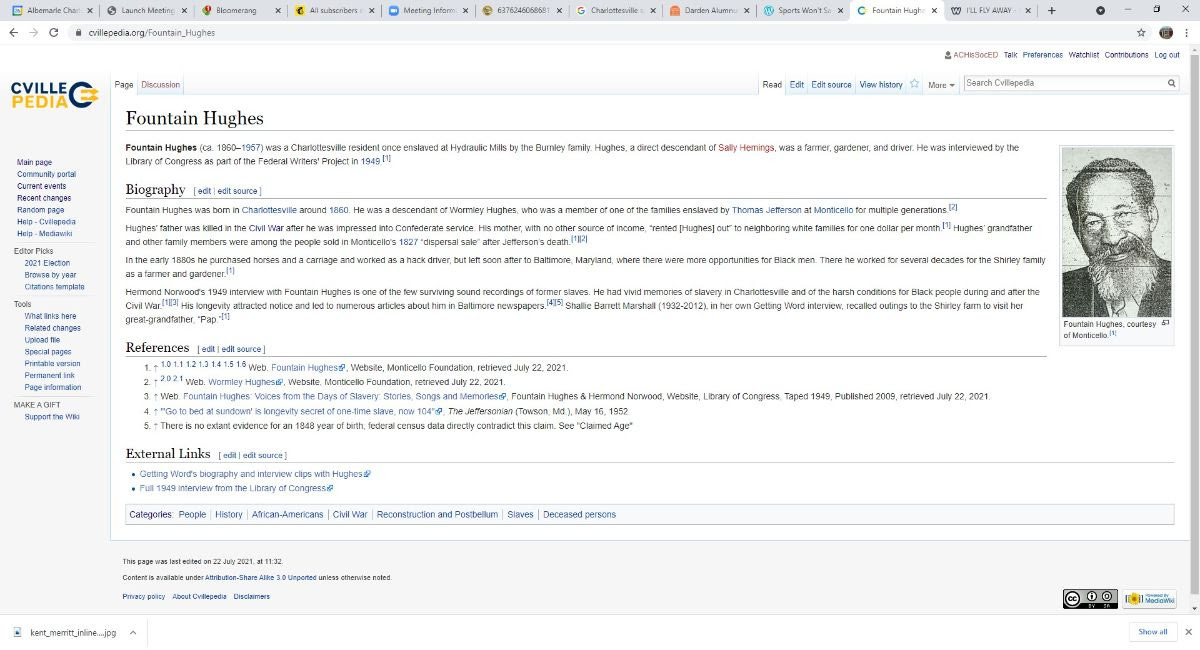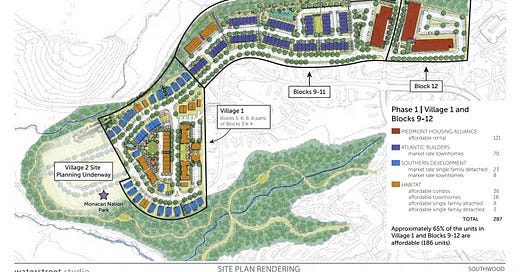In today’s Patreon-fueled shout-out: Help support black-owned business in the Charlottesville area. Check out the Charlottesville Black Business Directory at cvilleblackbiz.com and choose between a variety of goods and services, ranging from beauty supplies, professional services, and e-commerce. Visit cvilleblackbiz.com as soon as you can to get started.
On today’s show:
Another update on the redevelopment of Southwood Mobile Home Park by Habitat for Humanity of Greater Charlottesville
Spotted Lanternfly spotted in Albemarle
Two Virginia community colleges have new names
Governor Ralph Northam announces federal ARPA funding fo water and wastewater projects
Governor Ralph Northam has announced plans to use $411.5 million of the state’s share of American Rescue Plan Act (ARPA) funding to invest in water and sewer infrastructure throughout Virginia. There is no list of projects provided in the release, but the announcement does state that $186.5 million will go to wastewater treatment plants, $125 million will go to assist Richmond, Alexandria, and Lynchburg replace their combined sewer overflow systems, and $100 million will go to water systems in small and disadvantaged communities. The Rivanna Water and Sewer Authority was set to discuss how it may seek out ARPA funds at its meeting today, and I’ll have that information in a future newsletter.
Yesterday, Governor Northam announced $250 million in ARPA funds to improve ventilation in public schools, and those projects will all require local matches. (release)
Earlier this month. Northam announced the use of more than $200,000 to bolster grants from the Virginia Main Street program run by the Virginia Department of Housing and Community Development. Several communities in the general area received funding:
The Town of Farmville will receive $25,000 on a wayfinding system identified in a 2020 study
The Town of Orange will receive $25,000 for the Orange Downtown Association and the Orange County African American Historical Society for placemaking in a town park
The Town of Altavista will receive $20,000 to add to an existing grant for the town’s Downtown Business Investment program to fill empty storefronts
Nelson County will receive $7,000 to create a market analysis and retail gap analysis for the village of Lovingston
An invasive insect that threatens a wide range of crops has been spotted in Albemarle County. The Virginia Cooperative Extension has confirmed the presence of Spotted Lanternfly this month. The extension is a service of Virginia Tech and Virginia State University, whose communication staff prepared an informational video.
“The Spotted Lanternfly, an invasive bug from China, has been wreaking havoc on agricultural crops and causing a nuisance in the Northeast since 2014,” the narrator narrates. “Now the pest has found its way to Virginia. The insect can attack everything from peach and apple trees to hops and grapes.
Extension agents have been training volunteers to monitor for the Spotted Lanternfly. Visit the Extension’s website to learn more and to find out how to report the species if you see a specimen.

Two new community colleges in Virginia have new names, and another has added one character to its title. The State Board of Community Colleges approved the changes last Thursday. John Tyler Community College in Chesterfield County will become Brightpoint Community College, and Lord Fairfax Community College in Fauquier and Fairfax counties will become Laurel Ridge Community College. Patrick Henry Community College will add an ampersand to become Patrick & Henry Community College due to it serving two southside counties in that area. (VCCS release)
All 23 colleges in the system are re-examining their names and the names of their buildings. John Tyler was the 10th president of the United States and a slaveholder who eventually served in the Confederate House of Representatives. (learn more on Brightpoint site)
In the case of Lord Fairfax, the school’s website states that before the institution opened, minutes from 1969 reveal there was a struggle to come up with a name.
“The workgroup unanimously agreed, based on his history and lack of any notable legacy, that if the college were being named today, the group would not recommend it be named for Thomas, the 6th Lord Fairfax,” reads the Laurel Ridge Community College website.
At least two other community colleges are expected to change their names. These are Dabney S. Lancaster Community College in Clifton Forge and Buena Vista and Thomas Nelson Community College in Hampton Roads.
In today’s second subscriber-supported public service announcement:
On Thursday, July 29, the Albemarle Charlottesville Historical Society will turn the spotlight on four interns who have been helping the organization on topics this summer. Tune in on YouTube or Facebook at noon to learn about work to identify people buried in the early 19th century in unmarked graves at Pen Park, how cvillepedia is being updated to have a more broad perspective on local history, and to learn more about the ACHS’s Race and Sports project. It’s part of the Albemarle Charlottesville Historical Society’s Unregulated Meanderings series. Register on Zoom!

In 2007, Habitat for Humanity of Greater Charlottesville purchased the Southwood Mobile Home Park in Albemarle County’s southern growth area for $7 million. Since then, the nonprofit agency has served as landlord of the site which currently has about 1,500 residents in 341 mobile homes. Since then, Habitat has been planning to redevelop it on a bigger scale that at the 16-unit Sunrise Trailer Court on Carlton Road. Megan Nedostup is a planner with Albemarle County.
“In 2016, the county partnered with Habitat through a Board resolution and then for fiscal year 2017 through fiscal year 2019, the Board of Supervisors included in their strategic plan initiative revitalizing urban neighborhoods,” Nedostup said.
In 2018, the Board agreed to contribute $675,000 to assist Habitat prepare its rezoning application for the first phase. In 2019, Habitat, the Board of Supervisors, and Albemarle Economic Development Authority entered into a performance agreement through which Albemarle would provide up to $1.8 million to help fund construction of affordable housing as well as $1.4 million in property tax rebates. Supervisors approved the first rezoning from R-2 to Neighborhood Model Development that year as well. (performance agreement)
“Four hundred and fifty maximum units were approved in this phase one,” Nedostup said. “The units included a mixture of residential townhomes, multifamily, single family, duplexes and a maximum of 50,000 square feet of non-residential was permitted under the code of development.”
Construction of several blocks is underway and at various stages of the review process. Some of the first units to go through the site plan are the ones being constructed by Piedmont Housing Alliance using Low Income Housing Tax Credits in Blocks 11 and 12. In all, Piedmont Housing is seeking to build 121 rental units in Southwood Apartments.
Blocks nine, 10, and the rest of 11 are mostly market-rate townhomes on the future New Horizon Drive to be built by Atlantic Builders
“There are 16 affordable townhomes,” Nedostup said.
Village One consists of Blocks 5, 6, and 8, with parts of Blocks 3 and 4. There are a wide range of unit types in this area. An illustrative plan depicts what developer is building what units and where. In all, 287 units are planned so far, with planning to get underway on Village 2 in the future.
Dan Rosensweig is the chief executive officer at Habitat for Humanity of Greater Charlottesville.
“We all know that you took a bit of a leap of faith with us when you recommended approval about two years ago,” Rosensweig said. “This is something a little bit different in that it was organized as a block plan which created a framework, a regulatory framework, which created flexibility for cohorts of residents to design the various moments within the new development.”
Rosensweig took the Planning Commission on a video fly-through of these sections, which you can watch as part of the YouTube video. That’s also the best way to get a full sense of where the project is at the moment. (watch)
One small detail, the first floors of each of the buildings that make up Southwood Apartments will be 12 feet high, which Rosensweig said will allow them to serve as commercial at some point in the life cycle of those buildings. Here’s another detail about the architecture of some of the residential units in Village One.
“One of the things that’s very important to us at Habitat and I know that it was important to you all in the rezoning process is that you can’t tell Habitat units from market-rate units so on every block there is a mixture of Habitat homes and market rate homes and we’ve coordinated with the market-rate builders to make sure our architecture matches up,” Rosensweig said.
Rosensweig said that during the rezoning, Habitat agreed to make 15 percent of the housing in the first phase below-market through various interventions to bring down the cost to future residents.
“So that would have been 50 of the 335 total units,” Rosensweig said. “We ended up 207 affordable units out of the 335 or 62 percent. That breakdown is about 80 Habitat units for purchase, six Habitat units for rent, and that will toggle a little bit. Some of the families may rent originally and then purchase the ones that they are renting.”
Piedmont Housing Alliance is building the rest of the subsidized units.
The original plan had been to not move any of the mobile homes during the first phase, but 25 units have had to be moved.
“In the initial phase, we had hoped not to move anybody at all,” Rosensweigh said. “That’s why we developed greenfields at first. We thought we might have to move a few. We’ve had to move a few more than we thought but none of them off-site. Out of an abundance of caution, we’re working with 25 families that are adjacent to the first construction zone that were a little too close for comfort.”
So far, eleven of the 25 trailers have been moved to other sections of the park and others should be moved by September. Rosensweig said Habitat has accumulated many trailers in its 14 years operating the site and was able to provide those in situations where the original structure could not be moved.
As for construction of new units, Habitat’s Chief Construction Officer said the first lots will be turned over to developers sometime this fall. Here’s Andrew Vinisky.
“We anticipate our first five Habitat homes and likely the first four market rate homes to be delivered some time next summer,” Vinisky said.
Work is underway now on the phasing for the rest of the Sunrise development. Attorney Lori Schweller of the firm Williams Mullen said staff has made a recommendation on how to proceed.
“We have been working closely with staff to plan for submittal of phase two and have been advised that an amendment to the existing zoning makes the most sense so we are preparing our concept plan and new code of development and hope to submit that in the fall,” Schweller said.
Commissioner Karen Firehock had several questions related to affordability.
“What percent or total number of the original units that you showed us a couple of years ago were supposed to be occupied by South residents?” Firehock asked. “How many are currently committed to existing residents? I’m trying to understand your success rate.”
“It’s actually going pretty well,” Rosensweig said. “We essentially canvassed the neighborhood and if you recall we’ve had numerous families who have been working toward this for a while so our first application process took place in the spring and we had 25 families step forward. Remember there are 49 homes in the first village, but they’re not all going to get built next year. There’s about 20 to 25 that are going to be get built every year so that was about the right number of families we needed to fill up the first buildings that we’re building.”
Rosensweig said the second application process will begin in August, and he expects all 86 Habitat units in the first phase to be occupied by current Southwood families.
“We can’t force anybody to stay in the neighborhood and so there will be some families who leave and we’re working one on one on a strategy with all of them,” Rosenweig said.
Rosensweig did not have a break down on the annual income for the first cohort of families, Southwood, but said the average AMI for a Habitat family is 32 percent of the area median.
Commissioner Tim Keller went back to the 1,500 people who are believed to be living at Southwood currently. He said with just over 200 affordable units in the first phase so far, that might not be be enough to accommodate all current residents who might want to live there.
“I’m concerned at least that what we’ve seen so far, that there could actually be a net loss [of affordable housing],” Keller said.
Rosensweig said that there is more of Southwood to be developed.
“This is phase one so this is 30 acres out of 123 so there are 207 affordable homes on roughly a fifth of the site,” Rosensweig said. “There is an area four to five times the size of what Phase One is that will accommodate more affordable housing so when we come back for the second phase of rezoning, that’s where the additional density of affordable housing and market rate housing wll be.”
Keller said the numbers of affordable units often appear to be in flux.
“It seems like each time we have these discussions we’re told there are going to be answers in the future and I just can’t believe you be doing this without having those kind of projections,” Keller said.
Commission Chair Julian Bivins noticed that all of the affordable rental units appeared to be clustered, with the 120+ rentals built by Piedmont Housing Alliance in Block 12 and many of the Habitat clustered in the middle of village one.
“And I’m sort of seeing all of the affordable housing units grouped together which means that people will sort of co-locate,” Bivins said. “When you bring this back for the second time, that will be one of the things I’m going to key off of.”
For another version of the story, please do check out Allison Wrabel’s July 16 story in the Daily Progress.















Share this post